

10/2004
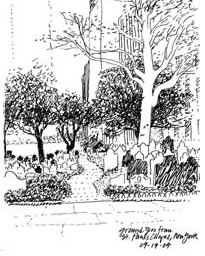 by
Lance Jay Brown, FAIA, and
by
Lance Jay Brown, FAIA, and
Kite Singleton, FAIA
The terrorist attacks of September 11, 2001, set in motion a torrent of emotions and actions in Lower Manhattan aimed at responding in an appropriate way, both psychologically and physically. The AIA “Learning from Lower Manhattan” conference, held September 17-19 at many locations in the heart of New York’s downtown, came forth through efforts of people with a deep investment in this neighborhood prior to these events who have actively participated in a wide variety of rethinking and reconstruction work since that day. Their commitment to the success of these endeavors was evident in the quality of the programs and the exposure they received.
Lessons learned
 Rebuild
commercial vitality: Carl Weisbrod, president of the Alliance
for Downtown New York, introduced the conference, describing the
growing office vacancy rate that preceded the attacks together with the
trend for converting outdated office buildings to residential use. Weisbrod
made an impassioned case for rebuilding the business and commercial vitality
of Lower Manhattan, the third largest business district in the nation.
Rebuild
commercial vitality: Carl Weisbrod, president of the Alliance
for Downtown New York, introduced the conference, describing the
growing office vacancy rate that preceded the attacks together with the
trend for converting outdated office buildings to residential use. Weisbrod
made an impassioned case for rebuilding the business and commercial vitality
of Lower Manhattan, the third largest business district in the nation.
Link airport to Ground Zero: Weisbrod praised the suggested funding of a proposal to link Kennedy Airport with a one-seat rail transit ride directly to Ground Zero through a new tunnel under the Harbor, together with completion of a similar connection to Newark Airport, indicating it was this kind of investment that would unlock the potential for Lower Manhattan’s regrowth. Skidmore Owings & Merrill’s Marilyn Jordan Taylor, FAIA, has been leading support for this proposal for several years. Not surprisingly, she strongly supported this view during the panel discussion in which she participated.
Keep the public dignity: Taylor also bemoaned the “dedignifying” of the public realm with poorly designed street furniture and, especially, the growing demand for security bollards that obscure and interrupt the natural flow of pedestrian activity. She called on the conference attendees to “keep building, hold consensus, leverage funding, remain vigilant, and demand vision.”
Use scant parking to reinforce public transit: The importance of public transit in the life of Lower Manhattan was particularly driven home with the report that only some 700 to 1,000 parking spaces are anticipated to be built with the proposed 10,000,000 square feet of office and commercial space at Ground Zero. For most of the nation’s cities, that would require ratios of 4 or 6 parking spaces per 1,000 square feet, a ratio of .7 per 1,000 indeed testifies to the value brought to this 24-7 city center by its investment in public transit.
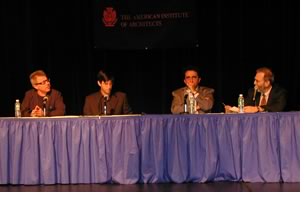 Keep
communications open: We witnessed the first meeting of three
of the key architects responsible for the planning and design of Ground
Zero’s reconstruction: Daniel Libeskind, AIA, the winner of the
competition for the master plan; Santiago Calatrava, architect for the
transit station to be built on the plaza designated by Libeskind as “the
wedge of light”; and Michael Arad, AIA, winner of the competition
for the memorial. (We were disappointed that David Childs, FAIA, Skidmore
Owings & Merrill, the architect selected by World Trade Center leaseholder
Larry Silverstein to design Freedom Tower, did not participate.)
Keep
communications open: We witnessed the first meeting of three
of the key architects responsible for the planning and design of Ground
Zero’s reconstruction: Daniel Libeskind, AIA, the winner of the
competition for the master plan; Santiago Calatrava, architect for the
transit station to be built on the plaza designated by Libeskind as “the
wedge of light”; and Michael Arad, AIA, winner of the competition
for the memorial. (We were disappointed that David Childs, FAIA, Skidmore
Owings & Merrill, the architect selected by World Trade Center leaseholder
Larry Silverstein to design Freedom Tower, did not participate.)
 Add residential?: We heard from John Belle, FAIA, author of the first
planning proposals that received such a resounding public rejection,
and learned how the Port Authority had severely restricted his latitude
in trying to relate the WTC program and site to the larger context of
Lower Manhattan. There was some pique in his presentation, referring
to the competition that followed his work as a “beauty contest” that
did little to further the more comprehensive revisions of program he
felt were important. He spoke convincingly about his view that the Port
Authority’s demand for 10,000,000 square feet of office space was
a “questionable number” and stated that he felt there should
be a residential element included in Ground Zero itself. This was the
first time that Belle had publicly spoken out concerning his frustration,
and his candor was met with prolonged applause and several statements
of support for one of New York’s most respected professionals.
Add residential?: We heard from John Belle, FAIA, author of the first
planning proposals that received such a resounding public rejection,
and learned how the Port Authority had severely restricted his latitude
in trying to relate the WTC program and site to the larger context of
Lower Manhattan. There was some pique in his presentation, referring
to the competition that followed his work as a “beauty contest” that
did little to further the more comprehensive revisions of program he
felt were important. He spoke convincingly about his view that the Port
Authority’s demand for 10,000,000 square feet of office space was
a “questionable number” and stated that he felt there should
be a residential element included in Ground Zero itself. This was the
first time that Belle had publicly spoken out concerning his frustration,
and his candor was met with prolonged applause and several statements
of support for one of New York’s most respected professionals.
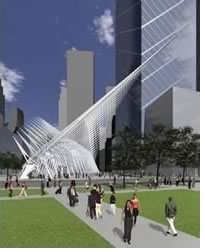 Restore a vibrant 24/7 character: Real-estate economist Hugh Kelly called
for maintaining and enhancing those factors that had made Lower Manhattan
such a successful place: density and clustering of a variety of activities;
accessibility through multiple routes; modern, Class A office space;
and a quality environment. He presented compelling statistics demonstrating
that real-estate values in cities that function 24-7 significantly outpace
those in cities that do not possess this multifaceted character. Kelly
also dropped one of the most memorable quotes of the conference: “Economic
markets treat planning dogma very rudely.”
Restore a vibrant 24/7 character: Real-estate economist Hugh Kelly called
for maintaining and enhancing those factors that had made Lower Manhattan
such a successful place: density and clustering of a variety of activities;
accessibility through multiple routes; modern, Class A office space;
and a quality environment. He presented compelling statistics demonstrating
that real-estate values in cities that function 24-7 significantly outpace
those in cities that do not possess this multifaceted character. Kelly
also dropped one of the most memorable quotes of the conference: “Economic
markets treat planning dogma very rudely.”
Stimulate waterfront development: Robert Yaro, president of the Regional Plan Association, observed that Venice, Amsterdam, and Paris have become “museums” and pleaded that Lower Manhattan should not. He encouraged the integration of Lower Manhattan’s prodigious public transit systems with ferry services as a way to stimulate more intense development activity on the waterfronts.
Consider the effect of service traffic: Lance Jay Brown, FAIA, raised the issue of access to Lower Manhattan for the enormous quantity of trucks and buses that will be needed to service the whole district as well as the new development and the memorial and called for a more comprehensive approach to keeping this traffic, especially service traffic, from compromising healthy and attractive pedestrian activity.
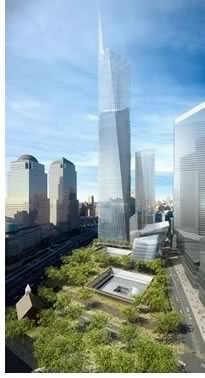 Keep
connectors sidewalk-oriented; commercially active: Jordan Gruzen,
FAIA, partner of Gruzen Sampton Architects, made similar comments about
the service traffic, and was the only participant in the conference who
criticized the Calatrava design, calling for a more sidewalk-oriented,
commercially active relationship between the transit station and the “wedge
of light” plaza. Gruzen also had some specific site-plan revision
ideas and called for a stronger role for Daniel Libeskind in controlling
modifications to the plan.
Keep
connectors sidewalk-oriented; commercially active: Jordan Gruzen,
FAIA, partner of Gruzen Sampton Architects, made similar comments about
the service traffic, and was the only participant in the conference who
criticized the Calatrava design, calling for a more sidewalk-oriented,
commercially active relationship between the transit station and the “wedge
of light” plaza. Gruzen also had some specific site-plan revision
ideas and called for a stronger role for Daniel Libeskind in controlling
modifications to the plan.
Use public subsidies for infrastructure: Vishaan Chakrabarti, AIA, director of the Manhattan Office of City Planning, encouraged the use of public subsidy for infrastructure improvements, not for stimulating new office development. He suggested that the new office buildings will develop naturally as the demand rises.
Learning from the tours
In addition to the general sessions, the conference offered a wide choice
of walking tours in Lower Manhattan: Skyscraper Museum, Battery Park,
Financial District, affordable housing in the Lower East Side, Tribeca/West
Street, Solaire sustainable housing, ferry terminals, linked open spaces,
Battery Park City, public transportation, and historical cultural resources.
Each tour was led by experts who were participants in
that specialty. For example, the public transportation tour was led
by Jim Wright, AIA, and Robert Eisenstadt, the two architects who were
primarily responsible for the incredibly rapid restoration of the PATH
commuter rail service from New Jersey to Ground Zero, and their enthusiasm
for their task was palpable. They told of the early decision of the
Transit Authority to simply pull the old subway station lines out of
the flat file, print them and call for bids, allowing the totally collapsed
subway tunnels to be back in operation in less than 24 months.
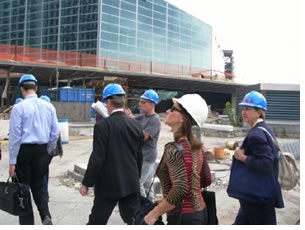 Saturday afternoon ended with a boat tour of the New York Harbor, emphasizing
the maritime nature of this city’s heritage so often forgotten
in the hustle of its intense urban streetscape. As the boat headed up
the Hudson River from the Statue of Liberty, the daylong overcast rose
to allow the sunset to highlight in glorious color the new and old buildings
of Lower Manhattan.
Saturday afternoon ended with a boat tour of the New York Harbor, emphasizing
the maritime nature of this city’s heritage so often forgotten
in the hustle of its intense urban streetscape. As the boat headed up
the Hudson River from the Statue of Liberty, the daylong overcast rose
to allow the sunset to highlight in glorious color the new and old buildings
of Lower Manhattan.
Sunday morning featured a tour of the rebuilt PATH terminal and Ground Zero. Robert I. Davidson, FAIA, PATH architect responsible for the “temporary” design, said it would last as long as needed until a new terminal was built. All agreed it was a miraculous achievement. The group entered Ground Zero, heard of the heroic effort to clear the site, and absorbed sights into the proposals under review and development. This most moving—sometimes tearful—visit will serve as a good foundation for those who return to see how the plans develop in the future.
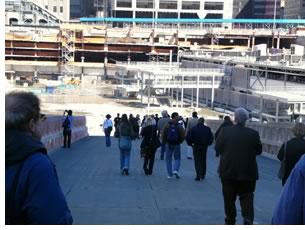 Positive can-do
Positive can-do
There was much to learn in “Learning from Lower Manhattan.” But
one lesson pervading these three days of non-stop presentations was the
atmosphere of can-do enthusiasm for responding to these malicious attacks
in a positive way. Not one word of anger or suggestion of retaliation
was uttered. Presenters and attendees alike appeared to grasp September
11 as a motivator, a way to focus our most creative instincts toward
recovery and boldly step forward to a bright future for Lower Manhattan.
It was a lesson for each of us to carry to our own communities facing
all kinds of trauma, natural disaster, disinvestment, and economic hardship.
It was truly an uplifting learning experience.
Copyright 2004 The American Institute of Architects.
All rights reserved. Home Page ![]()
![]()
 |
||
Lance Jay Brown, FAIA, serves as chair of the AIA’s Regional and Urban Design Committee and ACSA Distinguished Professor at City College of New York. E. Crichton “Kite” Singleton, FAIA, runs his own eponymous firm in Kansas City, where he has been active in community design since 1965. The “Learning from Lower Manhattan” conference was presented by the AIA New York Chapter and the AIA Regional and Urban Design Committee, Housing Committee, Public Architects Committee, Committee on the Environment, and Center for Communities by Design. Leaders
of the conference included:
|
||